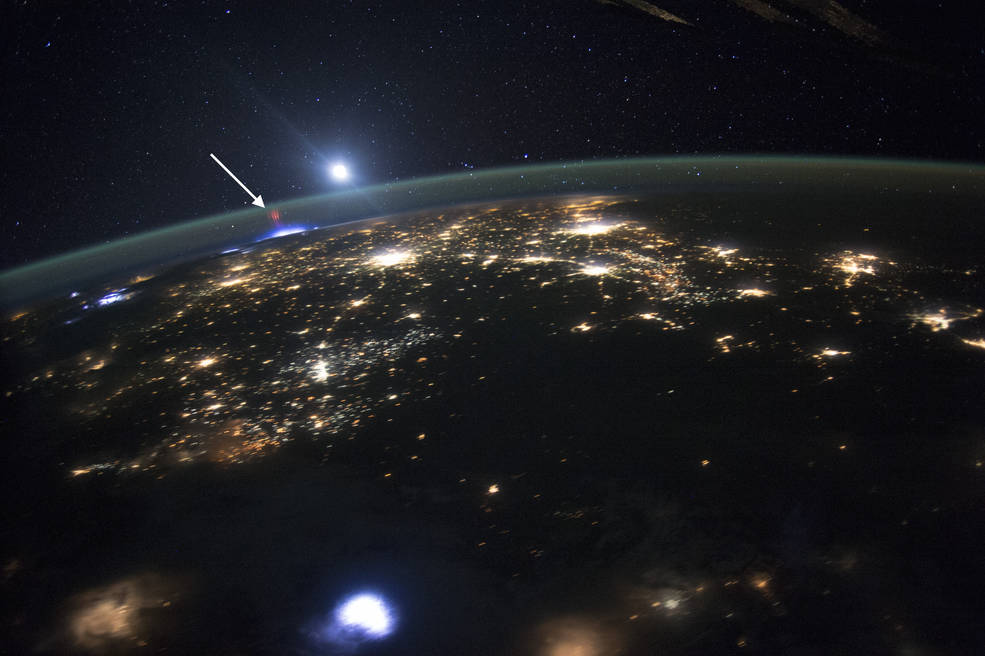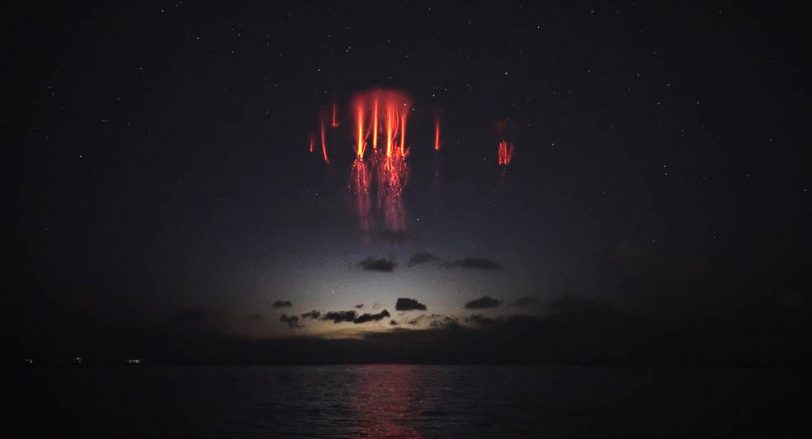A bolt of lightning, followed by something else. A crimson figure blinks in and out of existence high above the storm. If you saw it, you were a lucky witness to a sprite, one of the most mysterious electrical phenomena in the Earth’s upper atmosphere. However, if you captured it on camera, your image could help lead to a groundbreaking scientific discovery.
Spritacular (pronounced sprite–tacular), NASA’s newest citizen science project, uses crowdsourcing to advance the study of sprites and other Transient Luminous Events, or TLEs. TLEs are a type of electrical phenomenon that occurs above thunderstorms and causes brief flashes of light. The new citizen science project aims to connect professional scientists with members of the public who want their photography to be used in scientific research.
“People capture wonderful images of sprites, but they’re shared sporadically over the internet and most of the scientific community is unaware of these captures,” said Dr. Burcu Kosar, a space physicist at NASA’s Goddard Space Flight Center in Greenbelt, Maryland and Spritacular principal investigator. “Spritacular will bridge this gap by creating the first crowdsourced database of sprites and other TLEs that is accessible and readily available for scientific research.”
Sprites appear at an altitude of about 50 miles (80 kilometers), high above thunderstorms. They occur moments after a lightning strike, as a sudden reddish flash with a variety of shapes, frequently combining diffuse plumes and bright, spiny tendrils. Some sprites like to dance over the storms, turning them on and off one by one. Many questions remain unanswered about how and why they form.

Credits: Copyright Thanasis Papathanasiou
Witness reports of strange flashes of light above thunderstorms date back hundreds of years, but the first such event was captured on camera in 1989. The University of Minnesota was testing a low-light TV camera for a future rocket flight mission. Their camera accidentally captured the very first credible evidence for what we now call sprites.
“It wasn’t a very high resolution or fast camera – they just captured two luminous blobs above a nearby thunderstorm,” Kosar said. “The whole field was kickstarted because a camera was pointed in the right direction at the right time.”
These enigmatic events were dubbed “sprites” by scientists, a reference to mythical fairy-like creatures from European folklore. The playful naming convention stuck as more types of TLEs were discovered. Scientists are currently researching ELVES, Halos, Blue Jets, Gigantic Jets, and other phenomena.

Credits: NASA
Yet we still have far too few observations of sprites and other TLEs, and there is much we don’t know. Some of the major outstanding questions include:
- How often do sprites occur? Why do they take the shapes they do?
- What conditions in the upper atmosphere trigger sprite initiation?
- How do sprites affect Earth’s global electric circuit, and what is their contribution to the energy in Earth’s upper atmosphere?
- How are sprites connected with gravity waves, which send wind-driven ripples of energy through our upper atmosphere?
Answering these questions could lead to major advances in the science of Earth’s upper atmosphere. But to get there, Spritacular needs your help!
Become a Spritacular Citizen Scientist
Spritacular’s first goal is to create an image database: a collection of observations of sprites and other TLEs that will aid in answering the questions raised above.
Many digital single-lens reflex (DSLR) cameras on the market are suitable for capturing sprites. The most difficult part is determining when and where to look. Spritacular aims to provide all the guidance you need for a successful capture by bringing together experienced “sprite-chasers” and providing educational support and resources.
If you believe you have photographed a sprite or other TLE, you can create an account and then submit your photos and photo details (time and location of the photograph) to Spritacular. Accurate time and location details are preferred, but approximate time and location details with sufficient detail will also be accepted. You must be the photographer who took the photo to submit it.
Scientists will review all photos submitted. Depending on the level of contribution, submitters who collaborate with scientists and whose image leads to a scientific study or discovery will be properly acknowledged or listed as a coauthor on the resulting scientific publication.
Spritacular is a NASA-funded citizen science project in collaboration with the Catholic University of America in Washington, D.C. The principal Investigator is Dr. Burcu Kosar and Co-Investigator is Dr. Jia Yue.
READ MORE: NASA Notices Unexpected Flashes of Light Reflecting Off Earth


